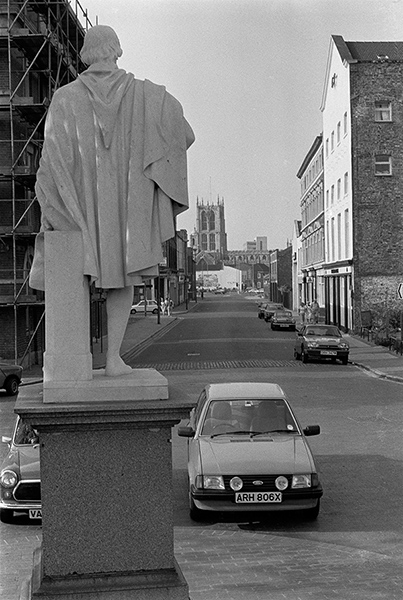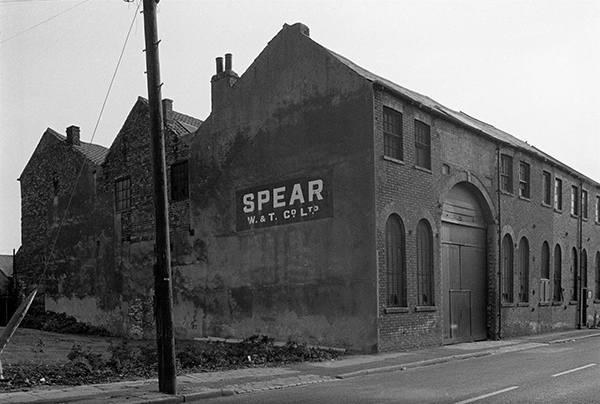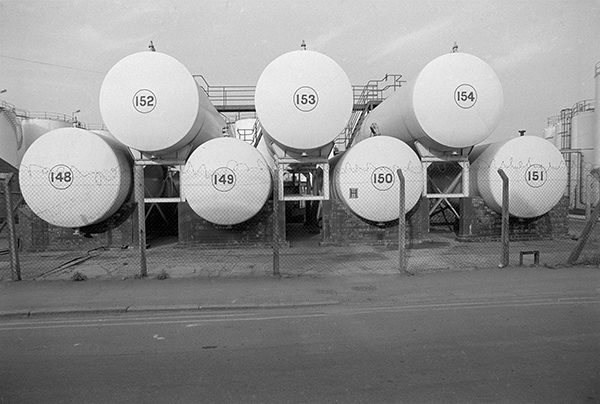Keeping up the daily postings throughout August, particularly when I was away from home presented a few minor problems, taking me back to hand-coding the web pages in my text editor and having to work off-line and then walk a short distance to get internet access, and I was pleased not to have missed a single day putting both the added image on my Hull Photos web site and also making these postings to my Facebook page – where you can read them daily. Comments are welcome either to this digest post or the daily Facebook posts
25th August 2017
The lifesize statue of Hull’s first mayor was commissioned for the new Town Hall in 1868 from Hull sculptor William D. Keyworth and unveiled in 1870. After the Town Hall was demolished in 1913 it was moved to its position here on Nelson St in 1920. It was Grade II listed this year as a part of Hull2017.
Inscribed on the pedestal is
SIR WILLIAM DE-LA-POLE,
KNIGHT BANNERET
FIRST MAYOR OF HULL, A.D. 1332-1335.
AN EMINENT AND MUNIFICENT MERCHANT,
HIS SOVEREIGN’S FRIEND, THIS TOWN’S BENEFACTOR,
LORD OF MYTON AND OF HOLDERNESS,
BARON OF THE EXCHEQUER,
FOUNDER OF THE CHARTER-HOUSE, HULL,
ANCESTOR OF THE NOBLE FAMILY OF SUFFOLK
HE DIED 21 APRIL 1366.
And on the plinth:
PRESENTED TO THE CORPORATION OF KINGSTON UPON HULL,
BY ALDERMAN ROBERT JAMESON J.P.,
MAYOR 1870-1871, 1871-1872, 1872-1873.
William de la Pole, Hull’s first Mayor, was a wool merchant and financier of both King Edward II and King Edward III, responsible for commandeering and commissioning ships for the King in the Hundred Years War and in 1339 was created a Knight Banneret and also Baron of the Exchequer. He represented Hull in Parliament, and with his son Michael established the Maison Dieu hospital in Hull and a Carthusian monastery – which later developed into the Charterhouse.
The sculpture has deteriorated in its exposed position here, and is probably best seen from the rear as it looks a little silly from the front – tastes in sculpture have rather changed. He seems to be looking down Queen St towards Hull’s Parish Church of Holy Trinity – now upgraded to Hull Minster, again for Hull2017 CoC.
The scaffolding at left is on the Grade II listed 1819 Pilot Office, disgracefully sold off for development and conversion to flats in 1998 after the privatised Associated British Ports decided that the property of the Humber Pilots belonged to them. The scaffolding in 1983 was for a refurbishment with the aid of a £2,000 grant from the Lord Mayor and City Council. The opposition by the pilots to the redevelopment is seen by some as the reason for ABP replacing the independent pilots by its own employees in the bitter dispute in 2001-2.
The Oberon pub at right, 44 Queen St is now a block of luxury flats – and the empty site at extreme right has been filled.

36s05: Nelson St, looking down Queen St, 1983 – Old Town
26th August 2017
The smoke house was built in the 1930s for C & J Horowitz & Co. Hull and the Hull and Humber Bacon Smoking Company, so it is perhaps not entirely correct to call it a fish smoke house, though this being Hull I’m sure it would also have smoked fish.
As names like Wellington St and Nelson St indicate, this area was developed in the early 19th century, reclaimed from the river marshes by the dumping of spoil from the excavation of Humber Dock (the dock was constructed from 1807-09), starting around 1804 though only named officially around ten years later.
The smokehouse was in an enclosed yard between Wellington St and Humber St and I couldn’t find a way to get a closer picture of it, and it was obviously in a semi-derelict state. The remaining the property along the north side of Wellington St including the sheds shown here were demolished in 2014/5. The south side had been rather badly redeveloped earlier, presumably after the closure of Humber Dock to shipping in 1967. The area around Humber St and Wellington St remained the centre of the wholesale fruit and vegetable trade, which had began when most arrived at Humber Dock, but by the time it closed mainly coming in lorries along the A63 a short distance north.
Before then these premises had been occupied by Brooksbanks Fine Foods, suppliers of potatoes, fruit and vegetables to the catering industry, and are now being replaced by rather bland blocks in the area now called the “Fruit Market” (which it no longer is), described by an estate agent as “a unique, characterful and stylish new community, combining premium residential developments with a vibrant retail, leisure and arts environment“, and where a one bedroom flat will cost you around twice as much as in other areas of central Hull.
There are nine fish smokehouses in Hull’s local list, none of which have national listing, and this one, recently restored for £133k by Hull City Council with an English Heritage grant is perhaps the least good example – and the restoration has made it into something of a joke. It was deeply disappointing not to see at least one of the other better examples listed in the ten properties selected for Hull’s year as UK City of Culture. It is perhaps another example of where a more significant local input might have been preferable.

36s06: Fruit merchants and Smoke House, Wellington St, 1983.
27th August 2017
A closer view of a building on Scott St extending to its corner with Catherine St that in previous post I identified as “built as the Vulcan Iron Works (unsurprisingly a common name for iron works) for Tindall & Co, Ironfounders. Around 1900 it was owned by Messrs Tindall, Earle and Hutchinson Ltd, Marine and General Engineers who among other things made engines for steel screw ships. In 1904 the works was divided and sold; among the occupants after this was H Smith & Co, Electrical Engineers.
It appears from this picture to be in reasonable condition and as I commented before could have been converted to other uses rather than demolished, along with other buildings in the area.

36s13: Former Vulcan Iron Works, Scott St, 1983 – River Hull
28th August 2017
These horizontal storage tanks have long gone from their site just north of the junction with Hodgson St, their site taken by a small office building for the bulk storage company, IBL Bulk Liquids formed close to here in 1947. The larger vertical tanks at both edges of the picture can still be seen, along with two horizontal tanks a few yards further up the road. There web site states they have “some 120 storage tanks, with individual sizes ranging from 50 to 1,700 cubic metres and a total capacity of around 34,500 cubic metres” in Hull at two sites on the River Hull and in the port area at King George V dock.
The tanks can handle a wide range of liquids, from edible oils to “aggressive and sensitive materials”.
Much of the industry that developed along the River Hull was concerned with oils, in the early days with whale oil and later until the present day with the extraction of vegetable oils, as well as in recent years waste oil reclamation.

36s25: Bulk Liquid Storage, Lime St, 1983 – River Hull
29th August 2017
I photographed this office on Great Union St, roughly opposite Hyperion St on several occasions because of its links with Hull’s heritage. The site is now occupied by The Crossings, a centre for the homeless which opened in 2011.
Surprisingly in 1983 it seemed a little tidier than in the previous year, though with the same plinth and posters. I wrote at some length about the Ruston marine engine and the poster of the coaster Surreybrook, next to the advert for PoLadaire who supplied the equipment that enabled deep sea trawlers to freeze fish at sea.
There were now several pieces of equipment on the display stand, and what I think is probably a heat exchanger proudly sitting on top of what had previous been an empty plinth.

36s31: Great Union St, 1983 – East Hull
30th August 2017
Companies House list the HULL SHIPS STORES(HOLDING)LIMITED as active from 06 Mar 1950 – 31 Dec 1976 and then continuing under the name to the HULL SHIPS STORES COMPANY LIMITED until 26 Oct 1987.
No 19 Bond was presumably a bonded warehouse where goods could be stored before clearing customs and paying import duties, VAT etc. The goods can only be removed when the appropriate duties have been paid.
This site is now occupied by L A Hall, Roofing Contractors and Merchants, whose gate also has an instruction to use the entrance in Spyvee St.

36s33: Hull Ships Stores Company No 19 Bond, Lime St, 1983 – East Hull
31th August 2017
Rank’s Clarence Mill, destroyed by bombing in 1941 were rebuilt after the war only to be senselessly demolished in 2016, shamefully destroying one of Hull’s landmark buildings. The section of the mills upstream, here with a Rank Hovis logo, remains, now occupied by cartridge manufacturer Shotwell.
Two small tankers from John H Whitaker’s fleet are moored in front of the mill, and two lighters, one the ‘R50’ and a small tug on the closer bank. A part of Drypool Bridge can just be seen at the left edge.

36s54: Clarence Flour Mills and River Hull, 1983 – River Hull
You can see the new pictures added each day at Hull Photos, and I post them with the short comments above on Facebook.
Comments and corrections to captions are welcome here or on Facebook.
______________________________________________________
There are no adverts on this site and it receives no sponsorship, and I like to keep it that way. But it does take a considerable amount of my time and thought, and if you enjoy reading it, a small donation – perhaps the cost of a beer – would be appreciated.
My London Diary : Buildings of London : River Lea/Lee Valley : London’s Industrial Heritage
All photographs on this and my other sites, unless otherwise stated, are taken by and copyright of Peter Marshall, and are available for reproduction or can be bought as prints.